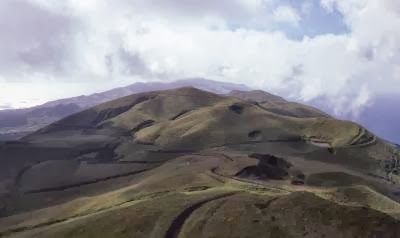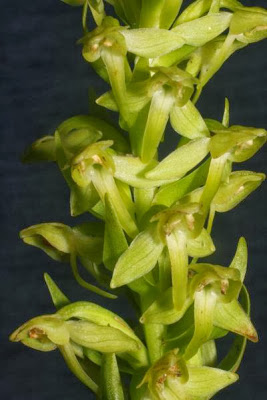

| Visitors Now: | |
| Total Visits: | |
| Total Stories: |

| Story Views | |
| Now: | |
| Last Hour: | |
| Last 24 Hours: | |
| Total: | |
Europe’s Rarest Orchid Rediscovered On ‘Lost World’ Volcano In The Azores
A lavishly illustrated publication, titled “Systematic revision of Platanthera in the Azorean archipelago: not one but three species, including arguably Europe’s rarest orchid”, was published today in the peer-reviewed open-access journal PeerJ.
This shows details of the flowers of Hochstetter’s Butterfly-orchid, a newly recognized and exceptionally rare orchid recently discovered on the Azorean island of São Jorge.
Credit: Richard Bateman
The research team, led by independent botanist Prof. Richard Bateman in collaboration with local botanist Dr. Mónica Moura (University of the Azores) and plant morphologist Dr. Paula Rudall (of the Royal Botanic Gardens Kew), originally viewed these butterfly-orchids as a simple, tractable system ideal for studying the origin of species and so they initiated a focused exploration of all nine Azorean islands.
A combination of field and laboratory research soon showed that butterfly-orchids first colonized the Azores from the Mediterranean rather than from North America, rapidly undergoing miniaturization of their ancestrally large flowers. It proved easy to distinguish the widespread Short-spurred Butterfly-orchid (Platanthera pollostantha) from the rarer Narrow-lipped Butterfly-orchid (P. micrantha) using morphology, DNA sequences, and the identities of mycorrhizal fungi associated with the roots of the orchids. However, this ‘simple’ study was thrown into disarray when Dr. Moura explored remote dwarfed laurisilva forests along the highest volcanic ridge on the central island of São Jorge and found an unusual population of butterfly orchids.
This is a view eastward along the spine of the Azorean island of São Jorge, showing the area where the new orchid has been discovered.

“I immediately recognised the flowers as being exceptionally large for an Azorean butterfly-orchid,” said Moura” and e-mailed images to Richard Bateman for confirmation that they were new to science”. Data gathered subsequently in the laboratory using several analytical techniques all pointed to the discovery of a new species, and suggested that the species – named Platanthera azorica in the PeerJ paper – originated relatively recently by a remarkable restoration of the large-flowered morphology of its presumed mainland ancestor.
Bateman then realised that this “new” orchid had in fact been illustrated (but never correctly identified as a new species) in the first ever Flora of the islands, published in 1844, but thereafter had consistently been confused with other more frequent Azorean species. The illustrated specimen, deposited in the herbarium at Tübingen by German botanist Karl Hochstetter, was collected during his tour of six of the nine Azorean islands in 1838. However, as Hochstetter did not visit São Jorge (where P. azorica was most recently ‘re-discovered’) it is entirely possible that the population he originally described may remain to be discovered on another Azorean island.
In the meantime, the team are anxious to obtain conservation protection for the newly-recognized and exceptionally rare orchid. “This remarkable species languished unrecognized for 173 years,” commented Bateman. “It’s rediscovery and recognition beautifully illustrate the value of integrating field-based and laboratory-based approaches to generate a modern monograph. This methodology both demonstrates that the species is genuine and allows us to make informed recommendations for its future conservation.”
Contacts and sources:
Richard Bateman
PeerJ
Source: http://www.ineffableisland.com/2013/12/europes-rarest-orchid-rediscovered-on.html



